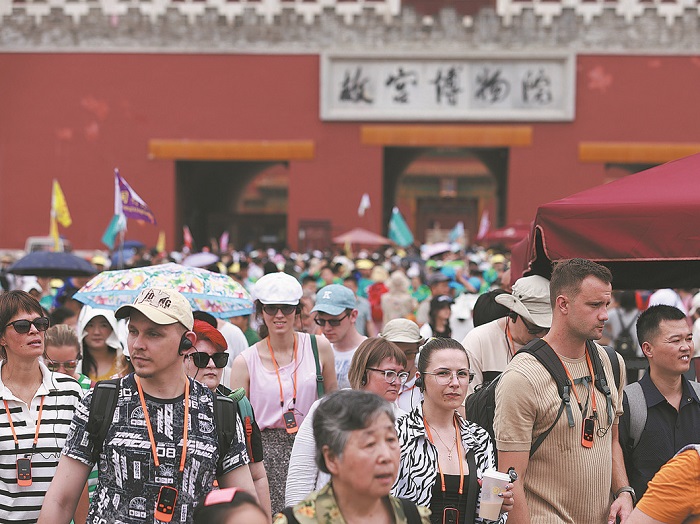Inbound travelers surge amid policy boost

Visitors, including many from overseas, view the sights at the Palace Museum in Beijing in July. JIA TIANYONG/CHINA NEWS SERVICE
Entries by foreigners at ports across China exceeded 17.25 million from January to July this year, a 129.9 percent increase compared with the same period in 2023, the National Immigration Administration said on Monday.
The NIA estimated that foreign visitors have boosted consumption by more than 100 billion yuan ($14 billion), with per capita daily average consumption reaching nearly 3,500 yuan.
The surge in foreign visitors to China is rooted in the impact of a series of policies in recent years aimed at facilitating entry by foreigners, it said.
The administration, working with relevant departments, has expanded the number of countries whose citizens are granted visa-free entry. It has also introduced more than 110 measures to facilitate the entry of foreigners into China since April 2018.
Liu Haitao, deputy director of the NIA, said that China's visa-free transit policy, which has been in place since January 2013, is continuously optimized in terms of applicable countries, ports of entry, duration of stay and available areas.
The policy has been a key factor in making it easier for foreign tourists to visit China, he added.
Liu said that the NIA has also introduced a number of regional visa-free policies, including 144-hour visa-free entry to Guangdong province for foreign tourist groups coming from the Hong Kong and Macao special administrative regions, 144-hour visa-free entry to Guilin, a scenic city in the Guangxi Zhuang autonomous region, for tourist groups from member states of the Association of Southeast Asian Nations, 30-day visa-free entry to Hainan province for citizens of 59 countries, and 15-day visa-free entry for foreign tourist groups arriving at coastal provinces by cruise ship.
Recently, a new 144-hour visa-free entry policy for Hainan has been implemented for foreign tourist groups registered in Hong Kong and Macao, benefiting more than 5.9 million foreign tourists, he said.
In addition, "application conditions for port visas have been further relaxed", Liu said. "Foreigners who urgently need to engage in business or other activities in China can now apply for port visas at 100 visa-issuing agencies in 73 cities nationwide. Various convenient services, such as reentry visas for foreign business and investment personnel, are also being provided."
From January to July, immigration authorities across the country issued about 846,000 port visas to foreign nationals who had urgent reasons to enter China but did not have enough time to apply for visas at Chinese embassies or consulates. That was a 182.9 percent year-on-year increase, according to the NIA.
Liu said the administration will continue to optimize visa-free transit policies, including expanding applicable areas, and will increase coordination with regions and relevant departments to improve the convenience for foreigners traveling to China.
Xu Xiaolei, chief brand officer of Beijing-based CYTS Tours Holding Co, said that under the combined effects of the 144-hour visa-free transit policy and other convenient immigration policies, entities in the market have seen significant positive outcomes. The measures not only facilitate tourists' travels but also promote the development of China's tourism industry, Xu said.
Since last year, in the wake of the impact of COVID-19, national departments as well as travel-related enterprises have devised numerous strategies to expedite the recovery of the tourism market, with the convenient entry and exit policies being among the initiatives, he said.
At the same time, these policies are conducive to showcasing China's image to the world, Xu said.
He noted that over a period of time, various national departments have continuously optimized aspects such as accommodations, transportation and payment options for foreign visitors coming to China.














